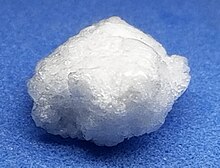
| |

| |
| Names | |
|---|---|
| IUPAC name
Lithium bis(trifluoromethylsulfonyl)azanide
| |
| Other names
LiTFSI
| |
| Identifiers | |
3D model (JSmol)
|
|
| ECHA InfoCard | 100.101.430 |
PubChem CID
|
|
| RTECS number |
|
| UNII | |
CompTox Dashboard (EPA)
|
|
| |
| |
| Properties | |
| LiC 2F 6NO 4S 2 | |
| Molar mass | 287.075 g/mol |
| Appearance | White solid |
| Odor | odorless |
| Density | 1.33 g/cm3 |
| Melting point | 236 °C (457 °F; 509 K) |
| 80.65% (22 °C)[1] | |
| Hazards | |
| Safety data sheet (SDS) | [1] |
| Related compounds | |
Other anions
|
Bistriflimide |
Except where otherwise noted, data are given for materials in their standard state (at 25 °C [77 °F], 100 kPa).
| |
Lithium bis(trifluoromethanesulfonyl)imide, often simply referred to as LiTFSI, is a hydrophilic salt with the chemical formula LiC2F6NO4S2.[2] It is commonly used as Li-ion source in electrolytes for Li-ion batteries as a safer alternative to commonly used lithium hexafluorophosphate.[3] It is made up of one Li cation and a bistriflimide anion.
Because of its very high solubility in water (> 21 m), LiTFSI has been used as lithium salt in water-in-salt electrolytes for aqueous lithium-ion batteries.[4][5]